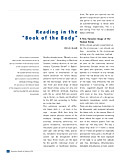 |
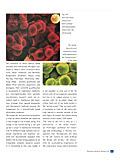 |
published in the magazine "Paracelsus",
2/VI 2009, S. 40-43, 3/VI 2009, page 37-39,
 |
Deutsch |
 |
Español |
|
Reading in the “Book of the Body”
by Ulrich Arndt
Goethe already knew: “Blood is a very special
juice.” According to Matthias Schobel, medical director of
the laboratory “Cytomed GmbH” in Baden-Baden, it is
even “the most important carrier of information of our health
condition”. An “entire library” presents itself
to the 53-year-old under the microscope, when he examines fresh
and dried drops of blood and blood smear, using not only one but
ten different methods: Starting with the so- called HLB test according
to Heitan, Le-Garde and Bradford to the OET test according to Professor
Linke (see box).
This extensive synopsis of different blood tests is – at least
in Europe – unique. With their help, the deeper seated physical
causes of, for example, allergies, inflammations, eczemas, immunity
deficiency, migraine headaches, neurodermatitis, rheumatic pains
as well as back pain, joint pain and aching limbs, psoriasis, metabolic
disturbances and even cancer can be recognized within one hour. These
results are the basis for the specific individual choice of naturopathic
or traditional medications. The latter are injected into the patient’s
acupuncture points or nerve end points in line with new forms of
an autohemotherapy or blood stem cell therapy respectively. This
is a fast-acting “First Aid” for a desolate body’s
defenses.
A New Dynamic Image of the
Human Being
While a blood sample is examined under the microscope,
I can already see how - according to the microscope setting and
the analytical method - the optical form of the blood changes in
many different ways, which can be seen on the connected monitor.
Sometimes Schobel shows me little red spots and granules, lemon-like
bubbles or a network of tiny threads within the red blood cells.
As he explains they “report” from the “library
of the body” how efficiently the cell respiration is functioning.
At other times, cogwheel-shaped red blood cells appear more or
less spiky and with more or less long “branches.” These
are indications of a dangerous metabolic breakdown, which could
even culminate into cancer.
There are also numerous formations to be discovered
and analyzed between the blood cells, in the plasma. Most of all
the threads
and globules swimming there inform the expert of the condition
of the immune system. Even dry blood can “tell long tales.” The
way a blood drop dries (if it forms a closed net or if holes are
present or especially pronounced lines) gives a multitude of information
about the toxic exposure of the body to so called free radicals
and thus developing inflammations, metabolic disturbances or even
cancer.
The inventors of these various blood analyses and connected therapies
represent a “Who is who” of holistic medicine: Aslan,
Bradford, von Brehmer, Burgerstein, Enderlein, Hauss, Linke, Pauling,
Pischinger, Reckeweg, Warburg, Wrba – doctors, professors
and Nobel Price winners, physicians and biologists. Their scientific
qualification is recognized in traditional medicine, but incomprehensibly
their partially revolutionary research could not establish itself
in traditional folk medicine. Instead, their special diagnostic
and therapeutic methods became the fundament for a scientifically
based alternative medicine.
The reason for this hesitant acceptance is that all these methods
are based on a new image of the human being. This image of the
human being is not split up (as is usual in traditional medicine)
into 10 different body systems (for example respiratory and digestive
system) and innumerable separate cells. Rather the human being
appears as an integrated, complex dynamic system in it. According
to this new model, it is not possible to view any of the 50 trillion
cells of our organism separately but has to be judged always in
connection with its so-called blood cell milieu. Each cell of our
body swims in the “primal ocean” that we carry within
ourselves in form of the extra-cellular (which is located outside
of the cell) liquid. As known the human being consists of but nearly
75% water.
“
The idea of the cell is only an (…) abstraction.” In
the 1970s, Professor Pischinger, professor for histology and embryology
in Vienna, recognized that “biologically the idea of the
cell cannot be used without the blood cell milieu.” He discovered
the outstanding importance of the connective tissue which presents
itself as a universal “transformation point” for all
materials, energies and information in the body. It does not matter
whether it is about vital nutrients, metabolic residues or environmental
toxins, about the transition of blood and lymphatic liquid into
and out of the vessels or about impulses into or out of the nerves.
For the first time it was possible to scientifically explain with
this so-called “basic system” and its related “basic
regulation” the effectiveness of a multitude of therapies
in alternative and research medicine up to acid/base diets and
fasting.During the last decades, well-known scientists developed
far reaching diagnostic methods where nothing more than a few drops
of blood are needed.
The most important blood diagnoses per
microscope
|
During the last decades, well-known scientists
developed far reaching diagnostic methods where nothing more
than a few drops of blood are needed.
- 1. Optical Erythrocytes Test (OET)
The red blood cells are surrounded by a thin layer
of at least four different plasma proteins. In
case of illness foreign or false proteins are
also stored in it, which normally are removed
during the usual “surface cleaning” by
the spleen. Certain antibodies belong to these
foreign proteins, which are amongst others typical
for cancer. Under microscope they appear as dark,
rod-shaped attachments. Their evaluation serves
an early diagnosis of cancer and recognition
of chronic inflammations.
- 2. Bacteria cycles according to Enderlein
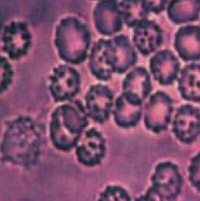 According to the microbiological theory by professor
Günter Enderlein (which was later confirmed
by von Brehmer) it is possible that, according
to the environment different morbid forms up
to bacteria and fungi are developed from vital
microorganisms (smallest living protein particles)
which exist in the blood. The different growth
cycles and stages are typical for certain clinical
pictures. They can be treated by special isopathic
medicines. In addition it is possible to exactly
determine if and when a dosis of antibiotics
is useful. According to the microbiological theory by professor
Günter Enderlein (which was later confirmed
by von Brehmer) it is possible that, according
to the environment different morbid forms up
to bacteria and fungi are developed from vital
microorganisms (smallest living protein particles)
which exist in the blood. The different growth
cycles and stages are typical for certain clinical
pictures. They can be treated by special isopathic
medicines. In addition it is possible to exactly
determine if and when a dosis of antibiotics
is useful.
From structures in blood plasma and the condition
of the white blood cells it is possible to back-reference
to the body’s exposure to environmental toxins
and harmful metabolic residues.
- 3. Cycles of somatides according to von Brehmer
Von Bremer rediscovered
the micro organisms
described by Enderlein
before and their
morbid effects
through milieu changes. His classification into
growth cycles, symptoms of sickness and the deductions
from that correspond extensively with the descriptions
of Enderlein (see above).
- 4. Blood test according to Scheller
With the help of the darkfield microscopy and according
to a diagnostic scheme developed by Dr. Hermann
Scheiter, the cell breathing process is evaluated.
The cell breathing process shows us the course
of the energy metabolism of the cell, the so-called
citric acid cycle, where carbohydrate-, protein-
and lipo-metabolism come together. The test can
also be used for early cancer diagnosis.
- 5. HLB-Test (Bradford Test)
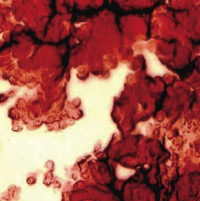 The test developed by Heitan, Le-Gard and Bradford
uses dried blood. The way the blood proteins
attach themselves and form a net, shows how the The test developed by Heitan, Le-Gard and Bradford
uses dried blood. The way the blood proteins
attach themselves and form a net, shows how the
body is burdened with free radicals according to
empirical values. Research by Dr. Bradford has
shown that all chronic and degenerative illnesses
are connected to certain free radicals. However,
the radicals can be neutralized with natural healing
remedies, enzymes, vitamins or other antioxidants.
- 6. Evaluation of the state of the basic system
Professor Alfred Pischinger discovered that the
connective tissue of the human being is the universal
reloading point for nutrients, oxygen and metabolic
residues. Not only the blood and lymphatic system
flow into this place but also the nerve endings,
so that their messages have to pass the “filter” of
the connective tissue first. Pischinger calls
the connective tissue a basic system because
of its central significance in the metabolic
and regulatory process.
From the microscopic analysis of the blood, it
is possible to find out the ability of the basic
system to transport substances.
It is possible to discover disturbances in the
blood caused, for example, by deposits of metabolic
and acid waste products in the form of protein
residues.
- 7. Evaluation of the cell phase according to
Reckeweg
All illnesses are caused by environmental toxins,
metabolic disturbances or free radicals according
to the homotoxicological teachings of Dr. Hans-Heinrich
Reckeweg. The body has different regulatory mechanisms
to eliminate them. Reckeweg allocated certain symptoms
of diseases to the regulatory mechanisms and divided
them into six phases where the blockage of the
natural regulation increases more and more. According
to this, eczemas, herpes and muscular rheumatism,
for example, represent a still controllable reactionary
phase of the immune system. However, physical symptoms
such as migraine, damages of the liver, pneumonia
and pre-states of cancer would indicate already
very dangerous blockages of the regulatory system.
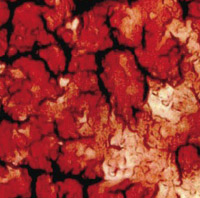 The intention of the treatment is to lead the patient
from higher back to lower phases where the body
could heal itself. The intention of the treatment is to lead the patient
from higher back to lower phases where the body
could heal itself.
With the help of the microscopic blood cell analysis
one can find out the contamination of the body
with toxins and its ability to eliminate waste
products. From this, the cell phase according to
Reckeweg is determined, together with the pattern
of the symptoms.
- 8. Evaluation of the enzyme condition according
to Wrba
Lack of enzymes and blockades lead to disturbances
of the metabolism and, last but not least, to the
different diseases. Due to certain atypical cell
structures it is possible to find out the enzyme
condition.
- 9. Additional Analysis
In the basic test by “Cytomed,” enzymes
and so-called (protein) risk factors in the blood
are determined through regular laboratory analysis
in addition to microscopic analysis.
In addition, the urine is examined for heavy metals,
nitrates, phosphates, ammoniuma and formaldehyde.
With the help of the “layer reaction” according
to professor Herget urine is searched for residues
of proteins, which allow an exact analysis of organs
disturbed in their function.
|
These results require totally different therapeutic
approaches. As an example, Schobel shows this on the basis of cancer
treatment: “School medicine removes a tumor by surgery or
kills it through chemical poisons or radioactive rays. However,
inflammatory factors, which build metastases, are overlooked and
this can lead to the well-known spreading and related tumors.” Holistic
medicine, however, would not focus on single cancer cells but on
the dynamic cell milieu of the entire organism, whose disturbance
lead to the condition where cancer could manifest in the first
place. The director of the Baden-Baden laboratory declares:
“
Only if a rehabilitation of this body milieu, and consequently
of the entire body, has been successful, the deeper causes of cancer
manifestation, such as chronic inflammations and stored toxins,
are removed.”
More than 2000 years ago, Hippocrates indicated with his “doctrine
of bodily juices” the central significance of the connecting
and regulating flow in the body and the dynamic contrary to the
static. Today, at least the blood can be exactly evaluated with
the help of precisely developed technical, analytical methods as
one of these dynamic elements.
The blood connects all cells in the body as “juice of life.” The
blood supplies the cells with oxygen and nutrients and takes the
metabolic residues to the organs of elimination as a “garbage
removal.” The blood plays an important role in the immune
system and is the medium of transportation for numerous chemical
messengers and hormones. If there are any disturbances in the metabolic
flow, inflammations and illnesses, one can find traces in the blood.
For example, these can be typical immune materials or enzymes,
foreign proteins from decay products or bacteria and viruses. During
the course of long years of research, the renowned scientists mentioned
before were able to allocate these kinds of “additions” to
the blood, to certain diseases and disturbances of health, so that
today’s different blood tests make extensive and differentiated
diagnoses possible.
Normally a doctor or a medical laboratory specializes in only one
single method of blood analysis, for example in the HLB test also
known under the name of Bradford Test, or in the OET test mentioned
before. Each single one of these analytical methods makes surprisingly
detailed statements about the health condition possible. The HLB
test makes statements about the contamination of free radicals,
which have a part in the manifestation of nearly all illnesses.
The OET test makes statements about disturbances that can lead
to cancer.
For the first time several of these methods are combined in the
Baden-Baden laboratory. Its medical director explains: “Only
in synopsis of the different single diagnoses the entire individual
health problem of the specific patient can be clearly crystallized
through varied confirmations and differentiations,” thus
winning an entire library of information from only a small amount
of blood. Mathias Schobel uses these methods during the first tests
as a kind of a basic medical check up of the patient. In addition,
further blood and urine tests are used, among others for the determination
of the contamination of heavy metals and other environmental pollutants,
known in traditional medicine as well.
This is an extraordinary effort that makes possible extraordinary
healings, as different examples of medical records show. Renate
K. tells: “I received six chemotherapies for the cancer in
both lungs. Afterwards I had to constantly use additional oxygen
supply. Even outdoors I could not take one single step without
a mobile breathing apparatus – almost like a diver or an
astronaut.” For half a year,, Renate K. lived under these
conditions without any improvement. For the first time in March
she came to Schobel. With the help of the blood tests, he chose
a particular medication, which significantly improved her health
condition. The 54-year-old says: “During the month of June
I was in Baden-Baden receiving the new serum and blood stem cells
therapy. Afterwards I definitively had the feeling that an inner
switch had permanently lead to health.” Today she does not
need any breathing apparatus, she can ride a bicycle and walk and
is completely cured according to the examination of the Hemer lung
clinic.
The secret of successful
Cures
The director of Cytomed can report numerous similar
cases. The secret of these successful cures are not only the different
blood counts, which Schobel has researched for more than 14 years,
and the individual choice of proper medication made possible this
way; a major part of these cures is also a new form of autohemotherapy,
which was developed by Mathias Schobel - the so called blood stem
cell therapy (see below). This method contains traditional and
alternative medicine, neural therapy and Chinese acupuncture, thus
bringing the “juices” and energies of the organism
into a harmonious flow again.
Bildquellen: ©Cytomed Gmbh, ©Ulrich Arndt 2x
| ----------------
Anzeige ---------------- |
More information
about the blood tests:
Cytomed GmbH
Maria-Viktoria-Str. 19
D-76530 Baden-Baden
Tel. +49-(0)7221-3453
Fax +49-(0)7221-3454
E-mail: info@cytomed.de
Internet: www.cytomed.de |
Author’s contact address:
|
Ulrich Arndt
Otto–Raupp–Str.5
79312 Emmendingen–Mundingen
Germany
Mail: info@horusmedia.de |
|


 According to the microbiological theory by professor
Günter Enderlein (which was later confirmed
by von Brehmer) it is possible that, according
to the environment different morbid forms up
to bacteria and fungi are developed from vital
microorganisms (smallest living protein particles)
which exist in the blood. The different growth
cycles and stages are typical for certain clinical
pictures. They can be treated by special isopathic
medicines. In addition it is possible to exactly
determine if and when a dosis of antibiotics
is useful.
According to the microbiological theory by professor
Günter Enderlein (which was later confirmed
by von Brehmer) it is possible that, according
to the environment different morbid forms up
to bacteria and fungi are developed from vital
microorganisms (smallest living protein particles)
which exist in the blood. The different growth
cycles and stages are typical for certain clinical
pictures. They can be treated by special isopathic
medicines. In addition it is possible to exactly
determine if and when a dosis of antibiotics
is useful.  The test developed by Heitan, Le-Gard and Bradford
uses dried blood. The way the blood proteins
attach themselves and form a net, shows how the
The test developed by Heitan, Le-Gard and Bradford
uses dried blood. The way the blood proteins
attach themselves and form a net, shows how the  The intention of the treatment is to lead the patient
from higher back to lower phases where the body
could heal itself.
The intention of the treatment is to lead the patient
from higher back to lower phases where the body
could heal itself.